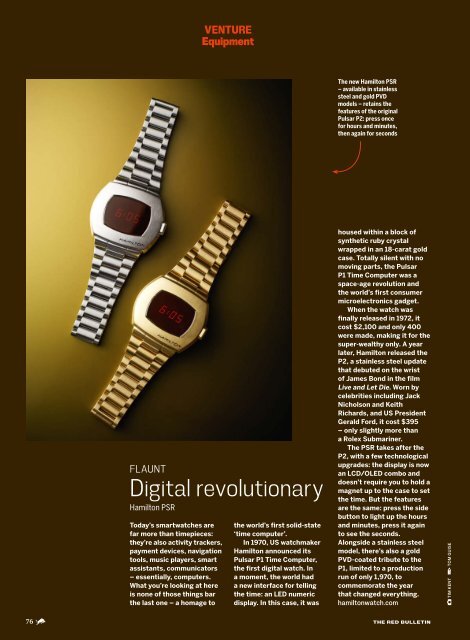You also want an ePaper? Increase the reach of your titles
YUMPU automatically turns print PDFs into web optimized ePapers that Google loves.
VENTURE<br />
Equipment<br />
<strong>The</strong> new Hamilton PSR<br />
– available in stainless<br />
steel and gold PVD<br />
models – retains the<br />
features of the original<br />
Pulsar P2: press once<br />
for hours and minutes,<br />
then again for seconds<br />
FLAUNT<br />
Digital revolutionary<br />
Hamilton PSR<br />
Today’s smartwatches are<br />
far more than timepieces:<br />
they’re also activity trackers,<br />
payment devices, navigation<br />
tools, music players, smart<br />
assistants, communicators<br />
– essentially, computers.<br />
What you’re looking at here<br />
is none of those things bar<br />
the last one – a homage to<br />
the world’s first solid-state<br />
‘time computer’.<br />
In 1970, US watchmaker<br />
Hamilton announced its<br />
Pulsar P1 Time Computer,<br />
the first digital watch. In<br />
a moment, the world had<br />
a new interface for telling<br />
the time: an LED numeric<br />
display. In this case, it was<br />
housed within a block of<br />
synthetic ruby crystal<br />
wrapped in an 18-carat gold<br />
case. Totally silent with no<br />
moving parts, the Pulsar<br />
P1 Time Computer was a<br />
space-age revolution and<br />
the world’s first consumer<br />
microelectronics gadget.<br />
When the watch was<br />
finally released in 1972, it<br />
cost $2,100 and only 400<br />
were made, making it for the<br />
super-wealthy only. A year<br />
later, Hamilton released the<br />
P2, a stainless steel update<br />
that debuted on the wrist<br />
of James Bond in the film<br />
Live and Let Die. Worn by<br />
celebrities including Jack<br />
Nicholson and Keith<br />
Richards, and US President<br />
Gerald Ford, it cost $395<br />
– only slightly more than<br />
a Rolex Submariner.<br />
<strong>The</strong> PSR takes after the<br />
P2, with a few technological<br />
upgrades: the display is now<br />
an LCD/OLED combo and<br />
doesn’t require you to hold a<br />
magnet up to the case to set<br />
the time. But the features<br />
are the same: press the side<br />
button to light up the hours<br />
and minutes, press it again<br />
to see the seconds.<br />
Alongside a stainless steel<br />
model, there’s also a gold<br />
PVD-coated tribute to the<br />
P1, limited to a production<br />
run of only 1,970, to<br />
commemorate the year<br />
that changed everything.<br />
hamiltonwatch.com<br />
TIM KENT TOM GUISE<br />
76 THE RED BULLETIN

















